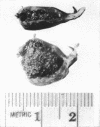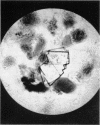Abstract
To study the pathogenesis of cholesterol gallstones, we fed 24 adult male prairie dogs a high cholesterol, egg yolk diet. 13 control animals received a cholesterol-free diet. All animals fed the egg yolk diet formed multiple gallstones in 2-6 months' time. These stones contained cholesterol, 77±14% by dry weight. No stones ocurred in the control group.
The egg yolk-fed animals developed bile of altered chemical composition. The cholesterol concentration of hepatic and gallbladder bile increased significantly. The molar ratios of bile acid/cholesterol and phospholipid/cholesterol decreased in hepatic and gallbladder bile. The predominant bile acid shifted from cholic acid, 78% of the total bile acids, to chenodeoxycholic acid, 60% of the total. In common bile duct cannulated animals the high cholesterol diet produced increased secretion of cholesterol by the liver and increased bile flow.
In animals fed the egg yolk diet for 2 months, cholesterol-4-14C was included in the daily diet for the next 4 months to establish an isotopic steady state. At autopsy the mean specific activity of cholesterol was similar in serum, liver, hepatic bile, gallbladder bile, and gallstones. Thus the cholesterol of gallstones apparently equilibrated constantly throughout the study and was not sequestrated as a static pool.
The high cholesterol, egg yolk diet caused the secretion of an “abnormal bile” which led to precipitation of cholesterol from micellar solution. The increased bile cholesterol relative to bile acid and phospholipid favored stone formation. This dietary induction of cholesterol gallstones provided a unique animal model, in part but not completely analogous to human cholelithiasis.
Full text
PDF








Images in this article
Selected References
These references are in PubMed. This may not be the complete list of references from this article.
- ABEL L. L., LEVY B. B., BRODIE B. B., KENDALL F. E. A simplified method for the estimation of total cholesterol in serum and demonstration of its specificity. J Biol Chem. 1952 Mar;195(1):357–366. [PubMed] [Google Scholar]
- Admirand W. H., Small D. M. The physicochemical basis of cholesterol gallstone formation in man. J Clin Invest. 1968 May;47(5):1043–1052. doi: 10.1172/JCI105794. [DOI] [PMC free article] [PubMed] [Google Scholar]
- Bourgès M., Small D. M., Dervichian D. G. Biophysics of lipid associations. 3. The quaternary systems lecithin-bile salt-cholesterol-water. Biochim Biophys Acta. 1967 Oct 2;144(2):189–201. [PubMed] [Google Scholar]
- Carey M. C., Small D. M. The characteristics of mixed micellar solutions with particular reference to bile. Am J Med. 1970 Nov;49:590–608. doi: 10.1016/s0002-9343(70)80127-9. [DOI] [PubMed] [Google Scholar]
- DAM H., CHRISTENSEN F. Alimentary production of gallstones in hamsters. Acta Pathol Microbiol Scand. 1952;30(2):236–242. doi: 10.1111/j.1699-0463.1952.tb00179.x. [DOI] [PubMed] [Google Scholar]
- DRYER R. L., TAMMES A. R., ROUTH J. I. The determination of phosphorus and phosphatase with N-phenyl-p-phenylenediamine. J Biol Chem. 1957 Mar;225(1):177–183. [PubMed] [Google Scholar]
- Dam H. Nutritional aspects of gallstone formation with particular reference to alimentary production of gallstones in laboratory animals. World Rev Nutr Diet. 1969;11:199–239. doi: 10.1159/000387579. [DOI] [PubMed] [Google Scholar]
- FOLCH J., LEES M., SLOANE STANLEY G. H. A simple method for the isolation and purification of total lipides from animal tissues. J Biol Chem. 1957 May;226(1):497–509. [PubMed] [Google Scholar]
- Freston J. W., Bouchier I. A. Experimental cholelithiasis. Gut. 1968 Feb;9(1):2–4. doi: 10.1136/gut.9.1.2. [DOI] [PMC free article] [PubMed] [Google Scholar]
- HOFMANN A. F., MOSBACH E. H. IDENTIFICATION OF ALLODEOXYCHOLIC ACID AS THE MAJOR COMPONENT OF GALLSTONES INDUCED IN THE RABBIT BY 5-ALPHA-CHOLESTAN-3-BETA-OL. J Biol Chem. 1964 Sep;239:2813–2821. [PubMed] [Google Scholar]
- IWATA T., YAMASAKI K. ENZYMATIC DETERMINATION AND THIN-LAYER CHROMATOGRAPHY OF BILE ACIDS IN BLOOD. J Biochem. 1964 Nov;56:424–431. doi: 10.1093/oxfordjournals.jbchem.a128013. [DOI] [PubMed] [Google Scholar]
- Ivey K. J., DenBesten L., Clifton J. A. Effect of bile salts on ionic movement across the human gastric mucosa. Gastroenterology. 1970 Nov;59(5):683–690. [PubMed] [Google Scholar]
- JUNIPER K., Jr, BURSON E. N., Jr Biliary tract studies. II. The significance of biliary crystals. Gastroenterology. 1957 Feb;32(2):175-208; discussion, 208-11. [PubMed] [Google Scholar]
- JUNIPER K., Jr PHYSICOCHEMICAL CHARACTERISTICS OF BILE AND THEIR RELATION TO GALLSTONE FORMATION. Am J Med. 1965 Jul;39:98–107. doi: 10.1016/0002-9343(65)90249-4. [DOI] [PubMed] [Google Scholar]
- Nakayama F. Composition of gallstone and bile: species difference. J Lab Clin Med. 1969 Apr;73(4):623–630. [PubMed] [Google Scholar]
- Nakayama F. Quantitative microanalysis of gallstones. J Lab Clin Med. 1968 Oct;72(4):602–611. [PubMed] [Google Scholar]
- Neiderhiser D. H., Roth H. P. Cholesterol solubilization by solutions of bile salts and bile salts plus lecithin. Proc Soc Exp Biol Med. 1968 May;128(1):221–225. doi: 10.3181/00379727-128-32983. [DOI] [PubMed] [Google Scholar]
- Osuga T., Portman O. W. Experimental formation of gallstones in the squirrel monkey. Proc Soc Exp Biol Med. 1971 Mar;136(3):722–726. doi: 10.3181/00379727-136-35350. [DOI] [PubMed] [Google Scholar]
- Rhodes J., Barnardo D. E., Phillips S. F., Rovelstad R. A., Hofmann A. F. Increased reflux of bile into the stomach in patients with gastric ulcer. Gastroenterology. 1969 Sep;57(3):241–252. [PubMed] [Google Scholar]
- Schoenfield L. J., Sjövall J. Bile acids and cholesterol in guinea pigs with induced gallstones. Am J Physiol. 1966 Nov;211(5):1069–1074. doi: 10.1152/ajplegacy.1966.211.5.1069. [DOI] [PubMed] [Google Scholar]
- TEPPERMAN J., CALDWELL F. T., TEPPERMAN H. M. INDUCTION OF GALLSTONES IN MICE BY FEEDING A CHOLESTEROL-CHOLIC ACID CONTAINING DIET. Am J Physiol. 1964 Mar;206:628–634. doi: 10.1152/ajplegacy.1964.206.3.628. [DOI] [PubMed] [Google Scholar]
- Tamesue N., Juniper K., Jr Concentrations of bile salts at the critical micellar concentration of human gall bladder bile. Gastroenterology. 1967 Mar;52(3):473–479. [PubMed] [Google Scholar]




